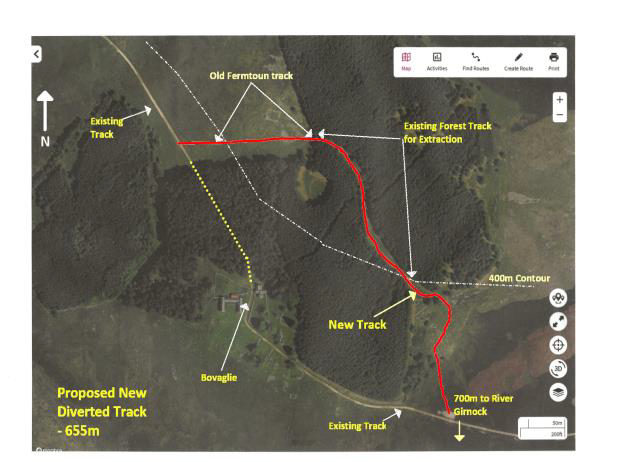
Many NEMT members will be familiar with this semi-ruinous farmhouse and steading at the head of Glen Girnock, and about 3 miles south-east of Balmoral: a popular walking route goes up the Glen, through the site, and over the moor to Easter Balmoral (or of course the reverse!). It lies on the Abergeldie Estate, which in 2001 was bought (other than the Deeside Castle, which has been retained by the Gordon family) by Alastair Storey, born and bred in the North-East, and head of a nationwide contract catering company.
In August 2023, Mr Storey applied for planning permission to convert the steading into a "new principal dwelling", and to reinstate the farmhouse; this application was withdrawn in November and resubmitted in December (as APP/2023/2294) to include demolition of the steading, whose foundations had apparently proved inadequate. The new building will be a large three-storey affair, to be "occupied by the owners of the estate, whilst the farmhouse will be occupied by relatives or visitors". A garage and plant room are also proposed.
An "Estate Vision Statement" by Mr Storey includes:

To date, public access to Bovaglie has been by estate track, from Glen Girnock for 100m or so along the side of a 20/30-year-old plantation, then between the steading and farmhouse, and exiting towards Balmoral through an older plantation, onto the moor. In order to create privacy, an additional planning application (APP/2023/2257) was submitted in December 2023: a new route - one of four considered - is to utilise an existing "ride" through the mature plantation about 150m behind the site (see map). This will divert from the current Girnock route about 600m to the south-east of the site, with a new track going about 200m up fairly open ground and into the wood. Beyond that, the route of an "old fermtoun track" over grass and heather will be utilised, partly on a considerable slope in order to avoid a more prominent line with water-crossing problems.
Considerable thought has obviously gone into the design and construction methods for the diversionary route, which is 740m long compared to the current 665m. But it will undoubtedly have a "harsh" appearance for several years, and, with surfacing, side-grading and drainage, will be very much a "landrover track" - to be used occasionally for forestry purposes - rather than a "path" for walkers, bikers and horse-riders. Signage and/or physical barriers (e.g. gates) are not specified in the application, nor how the estate will maintain access to the development site from the Glen Girnock direction.
For walkers and others, perhaps the main issue with the new route is the loss of the viewpoint towards Lochnagar from the obvious stopping points for anyone visiting Bovaglie, i.e. from in front of the buildings, or even from beneath the ancient kailyard trees standing a little to the southeast (see orange star on map). Mr Storey proposes a "programme of works whereby the existing track from the start of the diversionary track on the S East of the site to the boundary of the development site would be removed and reinstated as moorland". This will mean that visitors will have to take the view from near the start of the diversion; this will be less satisfying, though Lochnagar is still visible from there (and it may be more sheltered near the trees).
Since 1358, the place has had at least 12 spellings, from Botwaglach to Balvaglie, with its meaning commonly taken as the Guard House (of cattle, from cattle-thieves). It is the subject of one of the best watercolours by the artist Howard Butterworth, and of the somewhat sad tune Bovaglie´s Plaid, composed by the famous Strathspey King, James Scott Skinner, who was introduced to the place by Queen Victoria.
An 1806 estate map shows that Bovaglia was once a collection of at least sixteen longhouses, scattered around three wells. In the mid-nineteenth century, when the royal family leased the Abergeldie estate, the Gordon family who lived at Bovaglie was evicted - by a brother who had the Royal favour - and the Victorian farmhouse was built in 1860. The evictee was John Gordon, later of Crovie House, Troup, who wrote the mainly genealogical Bovagli Manuscript. The last of the Bovagli Gordons to live in the house was Miss Lizzie Gordon (born there in 1865), who continued the tenancy until the 1930s; she entrusted the management of the estate to her nephew Victor Cook of Countesswells House, Bieldside. The very last to farm Bovaglie was James Esson, from 1957 till 1981. After that, the area was let out to graziers, but with no agreement on maintaining the fences, even this stopped in 1994 (for details on all this, see within holeousia.com).
Postscript: At time of writing, no decisions have been announced on either of the two current planning applications. (Plan from Aberdeenshire website).
Please let the webmaster know if there are problems with viewing these pages or with the links they contain.